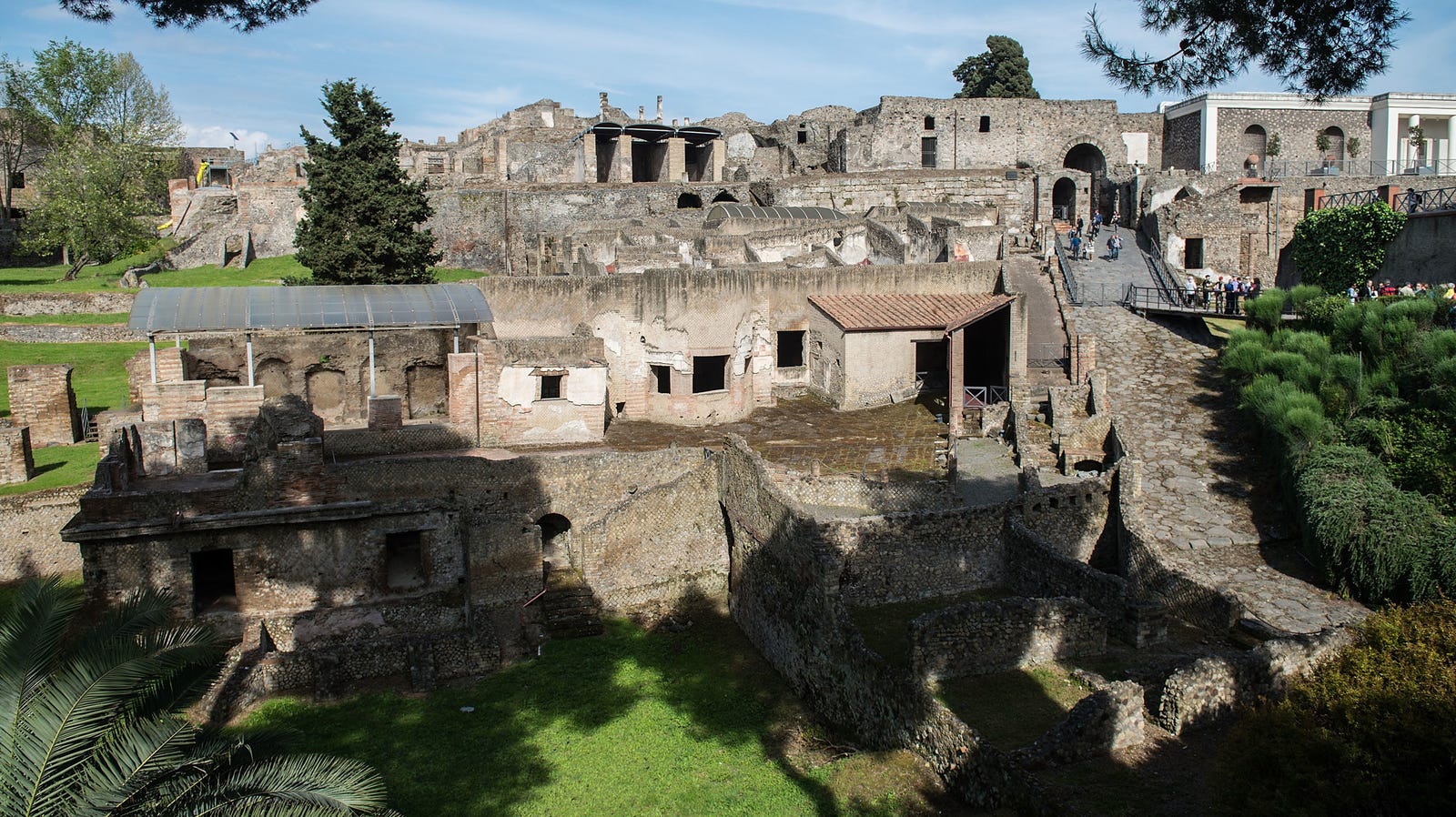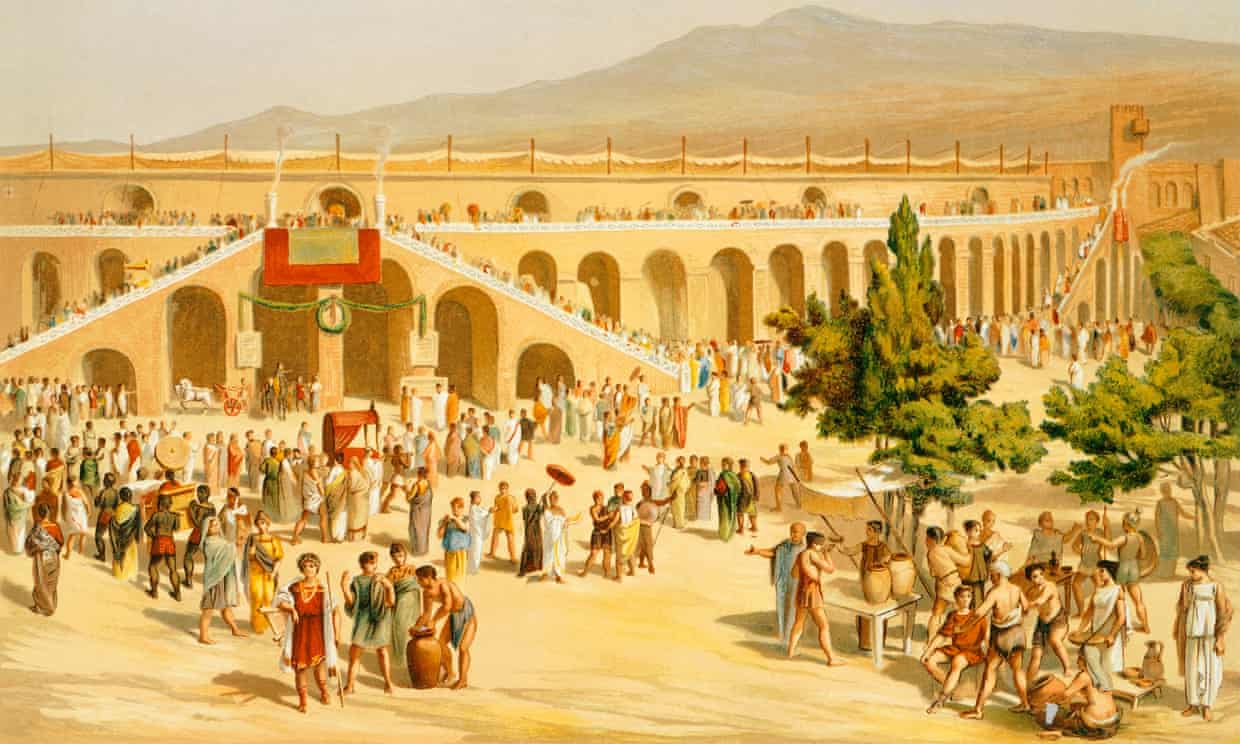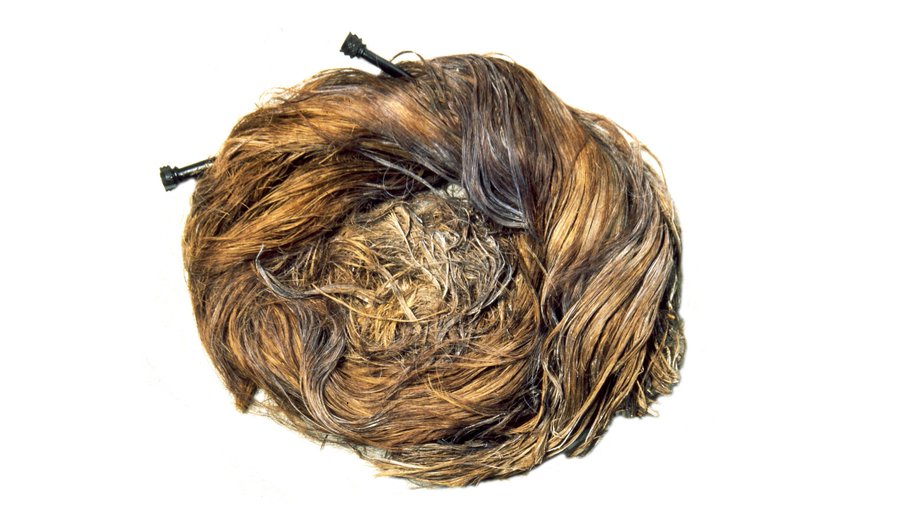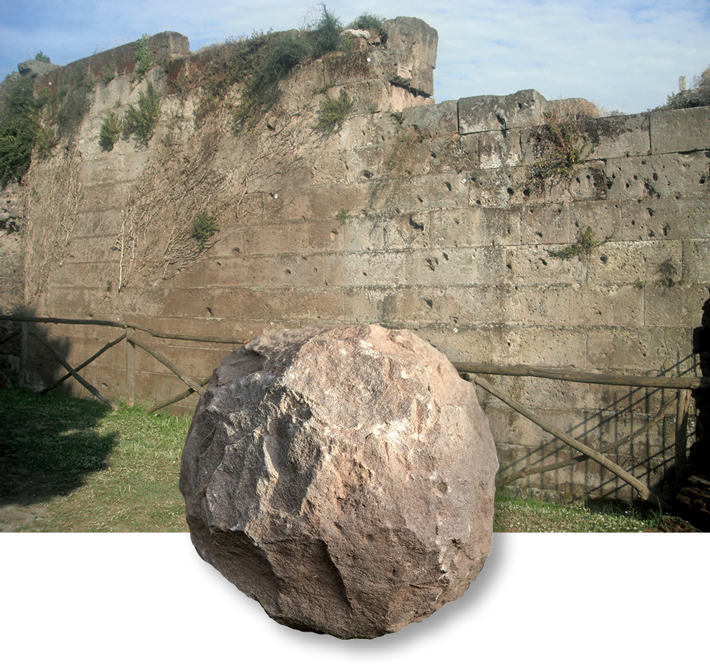The Roman Archaeology Blog is concerned with news reports featuring Roman period archaeology. If you wish to see news reports for general European archaeology, please go to The Archaeology of Europe Weblog.
Thursday, April 30, 2020
Drone video shows new excavations at Pompeii
Photography often takes us places we can’t go ourselves. And drone photography takes us even farther than most cameras can. So are we able to get this amazing drone video surveying new excavations in the ancient city of Pompeii.
The drone video provides a wide overview of Regio V of Pompeii, the latest part of the city to be unearthed, over the past two years. It starts off with sweeping vistas over the entire neighborhood. Then it dives down to navigate the ruins of two unique houses, getting close enough that you can see the tiles in floor mosaics.
The archeologists prepared a stunning video tour, narrated in Italian. But English subtitles make the story clear. The tour focuses on the street Vicolo dei Balconi, with houses on either side.
Read the rest of this article...
The British Museum is displaying 4 million items from its collection online
Photograph: The Lewis Chessmen. © The Trustees of the British Museum
Got some browsing time on your hands? Load up the British Museum’s website. Yesterday the museum decided to do an earlier-than-planned unveil of its revamped online collection. It’s now the biggest database of any museum in the world, with more than 4 million objects to click through.
The collection features the museum’s most famous artefacts, like the Rosetta Stone, the Parthenon Sculptures, along with every item the institution holds from Ancient Egypt.
But there are some new additions too – including 280,000 new object photographs that are being published for the first time. Among them are images of 73 portraits by Damien Hirst and a watercolour by the Pre-Raphaelite Dante Gabriel Rossetti that until recently had been thought lost. You can also look for works by Kara Walker, William Hogarth and Rembrandt in a digital archive of 75,000 art prints. If you’re more into coins, they have about 50,000 of those – medieval, Tudor, the works. Fill your boots.
Read the rest of this article...
Wednesday, April 29, 2020
OSTRICH EGG VESSEL, SILVER THRACIAN HORSEMAN FOUND IN ROMAN ERA BURIAL MOUND NEAR BULGARIA’S LYASKOVETS
The extremely intriguing artifacts discovered in the Thracian Roman-Era burial mound near Bulgaria’s Lyaskovets, including the ostrich egg vessel, the silver, gold-plated Thracian fibula, and the ceramic vessel decorated with a human face mask.
Photo: Veliko Tarnovo Regional Museum of History
The burial mound in question is located near the St. Peter and St. Paul Monastery, Lyaskovets Municipality, Veliko Tarnovo District, in Central North Bulgaria.
It was 50 meters in diameter and 1 meter tall, and dates back to the 2nd – 3rd century AD.
All of Ancient Thrace south of the Danube was conquered by the Roman Empire in 46 AD, with the Thracian aristocracy and population becoming well integrated in Roman life.
Read the rest of this article...
Monday, April 27, 2020
Site of battle fought between Carthaginians and Carparthians in 220 BC discovered in Spain
Illustration of a Second Punic War: the Roman general and statesman Publius Cornelius Scipio Africanus meets the Carthaginian leader Hannibal (bearded, on left) before defeating him at the Battle of Zama
[Credit: Getty Images]
The year was 220 B.C. and the young Carthaginian general Hannibal Barca had to return to his winter quarters in Qart Hadasht – now Cartagena in southeast Spain – after taking Helmatica – now Salamanca in the northwest of the country – from the Vettones tribe. It was spring or summer, and the 27-year-old and his troops had to overcome two obstacles to get to their destination: firstly, the wide rivers and high mountains that were difficult for their 40 elephants to cross; the secondly, the hostile local Carpetani, Vettone and Olcade tribes, who sought revenge for the destruction of their crops and cities.
With just 25,000 soldiers, Hannibal managed to defeat 100,000 enemies. Nobody knows where exactly this battle took place, only that it happened somewhere along the banks of the Tagus River, which stretches 1,007 kilometers from the province of Teruel in Spain to Lisbon in Portugal.
Read the rest of this article...
If the Ancient Romans Could Recycle, Then So Can You
A wide shot of the Pompeii archaeological site in Italy.
Photo: Giorgio Cosulich (Getty Images)
A team of researchers at Pompeii recently discovered evidence that Romans were avid recyclers, according to a weekend Guardian report. It figures that the same society that brought us urban planning, indoor heating, and concrete was also ahead of its time with going green too.
Preserved piles of trash, some several meters high, found outside the city walls are believed to have been “staging grounds for cycles of use and reuse,” according to professor Allison Emmerson, an American academic with the University of Cincinnati’s excavation team. While researchers had previously discovered similar garbage heaps around Pompeii, the prevailing theory was that they were created by an earthquake that hit the city nearly two decades before the infamous Mount Vesuvius eruption in 79 AD buried it in volcanic ash.
In fact, many had already been cleared away in the mid-20th century, the Guardian reported. But upon examining a few newly discovered trash heaps, Emmerson and her fellow archaeologists Steven Ellis and Kevin Dicus were able to trace the journey of these bits of plaster, ceramic, and other refuse.
Read the rest of this article...
Sunday, April 26, 2020
Pompeii ruins show that the Romans invented recycling
A reproduction of the market square, from The Houses and Monuments of Pompeii,
by Fausto and Felice Niccolini, 1854-96.
Photograph: DEA/G Dagli Orti/De Agostini via Getty
Excavations reveal that rubbish left outside the city walls wasn’t just dumped. It was being collected, sorted and resold
They were expert engineers, way ahead of the curve on underfloor heating, aqueducts and the use of concrete as a building material. Now it turns out that the Romans were also masters at recycling their rubbish.
Researchers at Pompeii, the city buried under a thick carpet of volcanic ash when Vesuvius erupted in 79 AD, have found that huge mounds of refuse apparently dumped outside the city walls were in fact “staging grounds for cycles of use and reuse”.
Professor Allison Emmerson, an American academic who is part of a large team working at Pompeii, said rubbish was piled up along almost the entire external wall on the city’s northern side, among other sites. Some of the mounds were several metres high and included bits of ceramic and plaster, which could be repurposed as construction materials.
Read the rest of this article...
Saturday, April 25, 2020
Museums are showcasing their creepiest objects, and this is how nightmares are made
We're kicking things off with this 3rd/4th century hair bun from the burial of a #Roman lady, still with the jet pins in place...
Some are providing virtual tours you can take from the comfort of your couch. And now, museums are making headlines once again – this time for challenging each other.
The only difference? You might not be able to sleep afterwards.
It all started on April 17 when the Yorkshire Museum in England took to Twitter.
Read the rest of this article...
Siege Weapons
(Ivo Van der Graaff, Hay Castle Trust)Top: City wall, Pompeii, Italy;
Above: Medieval catapult stone, Hay-on-Wye, Wales
Some time around 89 B.C.—the exact year is debated—Roman forces led by the general Lucius Cornelius Sulla laid siege to the city of Pompeii, likely in response to its residents’ agitation for full Roman citizenship. The walls on the city’s north side, where fortifications were particularly weak, still bear the impact marks of projectiles fired by the attacking Romans. In a number of areas inside the city walls, archaeologists have found catapult balls, small lead slingshot bullets, and machine-launched arrows known as scorpio bolts, all fired during the siege. “I don’t think anyone at the time was under any illusions that sustained bombardment would actually bring down the walls,” says archaeologist Ivo Van der Graaff of the University of New Hampshire. “It looks like one of the Romans’ tactics was to just fire munitions into the city to cause damage and, perhaps, lower morale.”
Read the rest of this article...
Friday, April 24, 2020
Archaeology breakthrough: 2,000-year-old find changing history of Roman Empire revealed
Five graves are shining light on the Roman Empire (Image: GETTY)
ARCHAEOLOGISTS were stunned by the discovery of five skeletons in Dorset, which is helping shed light on the Roman Empire's stronghold over Britain at the end of the Iron Age and its decline before the Dark Ages.
The Durotriges were one of the Celtic tribes living in Britain, prior to the Roman invasion in 43AD, who resided in modern Dorset, south Wiltshire, south Somerset and Devon. Dr Mike Russell is a senior lecturer in prehistoric and Roman history at Bournemouth University, who is co-director of a project looking into the transition from the Iron Age to the Roman period. In 2015, his team of archaeologists discovered five skeletons at Winterborne Kingston, which gave an incredible insight into life expectancy, religious views and diseases at the time.
Read the rest of this article...
Wednesday, April 15, 2020
Probable Roman shipwrecks unearthed at a Serbian coal mine
Thanks to the pandemic, radiocarbon dating and further excavations are on hold.
Coal miners in Serbia recently dug up an unexpected surprise: three probable Roman-era ships, buried in the mud of an ancient riverbed for at least 1,300 years. The largest is a flat-bottomed river vessel 15 meters (49 feet) long, which seems to have been built with Roman techniques. Two smaller boats, each carved out from a single tree trunk, match ancient descriptions of dugout boats used by Slavic groups to row across the Danube River and attack the Roman frontier.
The Kostolac surface mine lies near the ancient Roman city of Viminacium, once a provincial capital and the base for a squadron of Roman warships on the Danube River. When the Roman Empire ruled most of Southern Europe, the Danube or one of its larger branches flowed across the land now occupied by the mine. The three ships lay atop a 15-meter- (49-foot-) deep layer of gravel, buried under seven meters (23 feet) of silt and clay, which preserved them for centuries in remarkably good condition—or did until the miners' earthmoving equipment dug into the steep slope to excavate for the mine.
Read the rest of this article...
Friday, April 10, 2020
Leap of faith: ancient Britons viewed hares and chickens as gods
The brown hare was considered too special to eat, as were chickens.
Photograph: Chris Upson/Getty Images/Flickr RF
Iron age research reveals modern Easter festivals not first to celebrate chicks and bunnies
Brown hares and chickens were revered as gods rather than reared for food when they were first introduced to Britain in the iron age, archaeological analysis suggests.
In research that shows modern-day Easter festivals were not the first to celebrate chicks and bunnies, a team of experts from the universities of Exeter, Leicester and Oxford have found evidence that the animals were buried with care and intact in the period that preceded the Roman invasion of Britain.
Historical evidence suggests Britons of the period associated the animals with deities and considered them too special to eat. Commentarii de Bello Gallico, Julius Caesar’s firsthand account of the Gallic wars, says “the Britons consider it contrary to divine law to eat the hare, the chicken or the goose. They raise these, however, for their own amusement or pleasure.”
Read the rest of this article...
Monday, April 6, 2020
Fourth Style Frescos of the Casa del Principe di Napoli, Regio VI, 7,8 in Pompeii.
I am working on the illustrations for my translation of Houses in Pompeii, Volume 1, Casa del Principe di Napoli and have also uploaded the color photographs of its Fourth Style frescos from the book to Wikimedia Commons so they can be used for teaching and research independent of the embedded images in the book. (Under U.S. law these images are in the public domain because the original artist has been deceased for more than 70 years.)
Roman wall paintings in Pompeii are divided into four periods that were originally delineated and described by the German archaeologist August Mau, 1840–1909. These periods are usually referred to as First, Second, Third, and Fourth but are also known as Incrustation, architectural, ornamental, and intricate. Wall paintings were not only used for decoration, as Roman interiors often had no windows, but were used as a guide to function and social orientation for invited guests as well as the public at the morning salutatio. They also reflected the social status of the household.
Read the rest of this article...
Friday, April 3, 2020
Archaeology project unearths rare Roman artefacts in Long Melford
Anne Grimshaw, Valerie Wiseman from Long Melford Heritage Centre with pottery expert Alice Lyons. (32370855)
On first inspection, members of Long Melford Heritage Centre had identified the object as a whistle or knife handle due to its distinctive shape.
More than 2,500 fragments of pottery dating back to the Roman and Iron Age were also discovered during the excavation.
Pottery expert Alice Lyons, who inspected the objects, said: “It was most unusual to have a secure, complete stratification sequence, proving occupation from the Iron Age through to the end of the Roman period.”
A large quantity of sheep and cattle bones containing butchery markings were also unearthed, an indication to the meat processing trade that took place in the village.
Other items of pottery were identified as imported pieces from Europe, including Spain, France and Germany.
Read the rest of this article...
Alternate history: what if Boudica had defeated the Romans?
Each month BBC History Revealed asks a historical expert for their take on what might have happened if a key moment in the past had turned out differently. This time, Jonny Wilkes asks Miles Russell what if… Boudica had defeated the Romans?
There came a moment when Iceni queen Boudica had good reason to believe her uprising would end in victory over the Romans. Beginning with her warriors and an alliance with a rival tribe, the Trinovantes, her horde of bloodthirsty Britons had kept growing as more joined her march through southern England in AD 60 from one success to the next. As well as ambushing and obliterating the Roman 9th Legion, she had burned Camulodunum (Colchester), Londinium (London) and Verulamium (St Albans) to the ground.
Read the rest of this article...
Subscribe to:
Posts (Atom)













